Contents
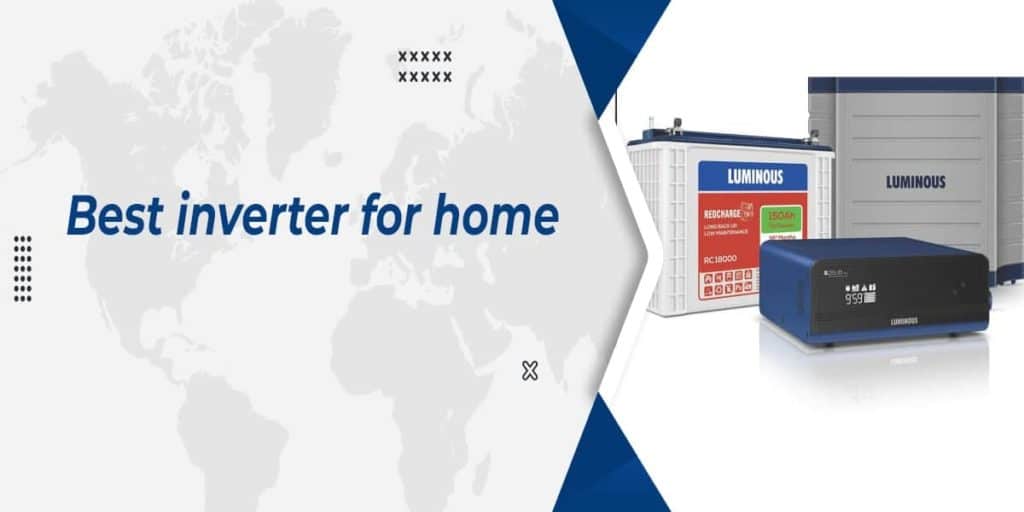
If you’re looking for the best inverter for home, you have a lot of options to choose from. Most people who are looking to add an inverter to their home usually want to have one that is not only easy to install but also that does not have to be constantly monitored.
There are many different types of inverters, so how do you know which one is the best for your home?
What Is An Inverter?
An inverter is a small electronic device that converts direct current (DC) into alternating current (AC). It is used in many countries around the world for various reasons.
One of the main reasons is to use or generate AC power from a DC power source that is not easily accessible. Another common use of inverters is to charge battery-operated devices.
This allows you to run appliances and gadgets that are powered by the mains, even if they were made for a different era of electrical power.
If you have any sort of electrical gadget at home – like a TV, radio, computer, cell phone, or anything else – you need an inverter. An inverter is also needed if you have any sort of solar power system.
Why Should You Use An Inverter?
Using an inverter is the best way to reduce your electricity bill. When you connect a device that consumes 120 volts of electricity to a regular outlet, it will use at least 7 amperes of current.
But, when you connect that same device to an inverter, it will only use about 3 amperes. This means that, by using an inverter, you can save as much as 40% on your electric bill.
But there are a lot of cheap, low-quality inverters on the market. That’s why we went and did the research for you. We’ve rounded up the very best inverters for homes on the market.
List Of Best Inverter For Home
You can get inverters in different sizes, wattages, and price ranges. But how do you know you are getting the right one for you? Inverters are used to convert the AC power from your wall socket into the DC power your devices need.
The type of inverter you need will depend on your needs. That’s why we went and did the research for you. We found and tested some of the best inverters you can buy for your home today. Choose the right one for your needs and budget.
1. Luminous Zelio+ 1100 Home Pure Sinewave Inverter UPS – Black
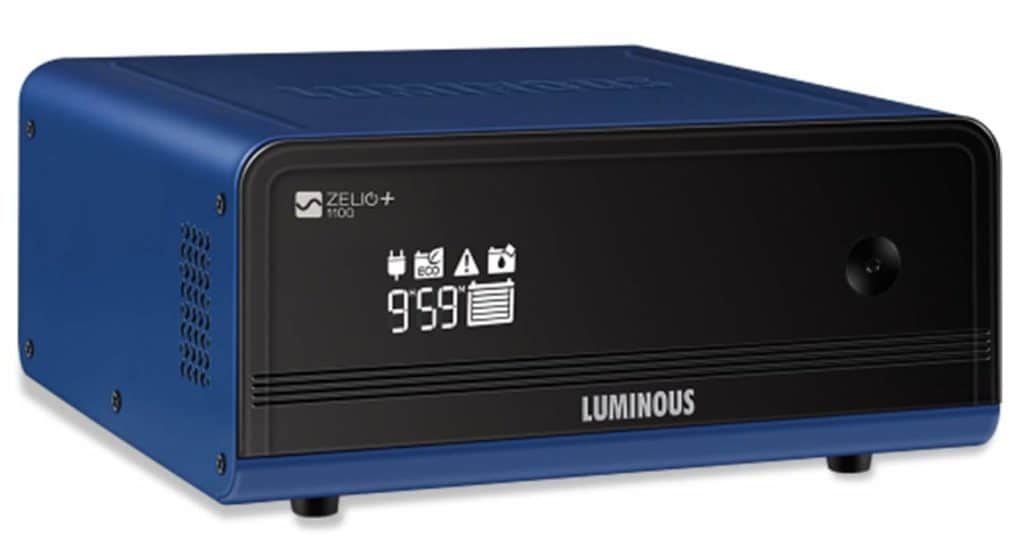
Luminous has been in the inverter business for many years now, and they offer a wide variety of products that are all engineered with quality and reliability in mind. Their inverters are no different – it comes with a 5-year warranty and a very helpful 1-year free repair service.
They offer a 1-year free repair service for any reason whatsoever, and they’ll even pay to have it shipped to you (at your expense) if you ever need to get it repaired.
In addition to that, Luminous offers a 2-year free replacement guarantee if you ever experience a failure of the inverter. This is an industry-first guarantee, and it applies to any reason whatsoever. No questions asked.
Another nice feature is that you can monitor the status of your battery on the LED display, which tells you how much charge remains, how many hours of backup power the inverter has left, and also lets you know when the battery needs to be replaced.
This is an excellent product from a company that has been around for decades and is well-regarded in the industry. If you’re looking for a dependable, long-lasting, high-quality inverter with all the bells and whistles, then this is the one for you.
Pros
- This inverter has a 5-year warranty so you know that if you ever experience a problem, they’ll take care of it.
- It comes with a 2-year free replacement guarantee so you can use it without any worries.
- LED display that tells you all sorts of useful information about the battery.
Cons
- It is not as efficient as other inverters.
- The inverter is a little heavy, weighing just over 11 pounds. It’s not light at all, but it’s not a huge burden either.
2. Luminous Zolt 1100 Sine Wave Inverter for Home, Office & Shops (Blue)
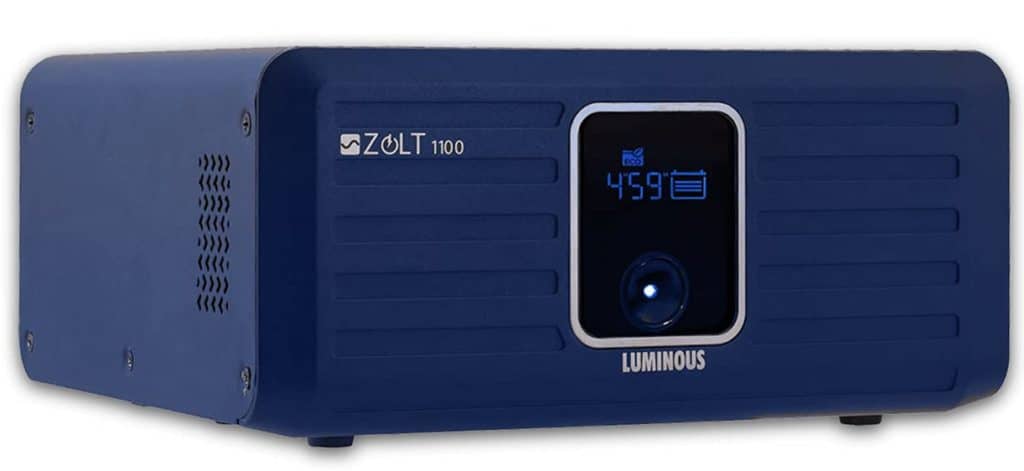
Luminous’ Zolt 1100 Inverter has a very bright display and offers plenty of room for customization. It’s one of the few inverters that can handle a wide variety of power loads including fluorescent lights, ceiling fans, and other appliances.
You can charge your mobile phone with it too, and it has a digital LED display that shows you how much power you have left in your battery. It even includes an automatic temperature control so that it can keep the room cool in the summer and warm in the winter.
This inverter is compatible with all types of batteries, and the built-in protection system is designed to prevent damage from overheating and short-circuiting.
The inverter is very easy to use too. All you need to do is plug it into the wall socket, select the number of watts you want to run, and then turn on the switch.
There’s a lot of flexibility in this inverter too, and you can set up the fan speed, turn on the lights, or adjust the temperature, all with a few simple clicks.
The remote control is also included so that you can manage everything from a distance. If you’re looking for an affordable, reliable inverter that’s also very user-friendly, then the Zolt 1100 is worth checking out.
Pros
- It can handle a wide variety of power loads, so you can use it for various types of devices.
- It has a bright display and plenty of room for customization that making it an ideal choice for users.
Cons
- It may not be the most powerful inverter on the market.
3. ZunSolar 1050 VA Pure Sine Wave ZRi PWM Home Inverter (White)

This inverter is manufactured by a company called “GPS Power” which is based in China. GPS Power has been in the solar business for over 20 years now, and they have a very good reputation for making high-quality solar panels.
The inverter that comes with the solar panel is also of high quality. It has a lifespan of 40,000 hours, and it comes with an 8-year warranty. It has a wide input voltage range of 130 to 280 V, which means that it can handle any type of PV module that you may have.
It is also equipped with a pure sine wave output, which is great for charging batteries. Batteries love this feature, as it prevents them from having to deal with any other types of waveforms.
This results in longer life, and better performance too. In addition to that, the solar panel and the inverter are both designed for low maintenance.
There’s no need to bleed off the electrolyte in the battery or clean the internals of the unit. This makes the whole setup last longer, and requires less of your time and energy.
The solar panel and the inverter also come with several useful features like an integrated charge controller, built-in LED indicators for the state of charge of the battery, and a super-low maintenance design. These features ensure that the battery will be charged safely, and it will retain its full capacity for a long time.
Pros
- This inverter is of very high quality along with a compact design and features.
- It possesses high-quality components and a wide input voltage range (130 to 280 V).
Cons
- The inverter does not come with a ground strap which could count as a disadvantage to it.
4. V-Guard Prime 1150 Digital Inverter UPS, white

This inverter is a heavy-duty inverter with all the bells and whistles you could want in a unit. It’s built like a tank and will handle anything you can throw at it without batting an eye. It has multiple protection features built into it, and it comes with a 5-year warranty.
This is a no-brainer if you’re going to be using this to power any type of high-end electronic equipment. It also has a very high-efficiency rating of 90% which is very good, but it can go even higher.
If you have a 220-volt system, then this is a great choice as it has a very high power factor of 0.97 which means it will draw less current from the power grid and thus save you money on your electric bill.
It also has surge suppression which is a must for any electrical device that has a microchip in it. The only downside to this inverter is that it doesn’t come with any type of battery charger.
You will need to purchase one separately if you want to use it with lead-acid or gel batteries. Overall, it is recommended to anyone who is looking for a budget purchase with some decent features and performance quality.
Pros
- Very heavy-duty construction with a high-efficiency rating of 90%.
- Very efficient with good protection features and surge suppression making it an ideal purchase.
Cons
- It doesn’t come with a battery charger
5. MICROTEK Ups 24Ã???7 Hb 950Va Hybrid Sinewave Inverter
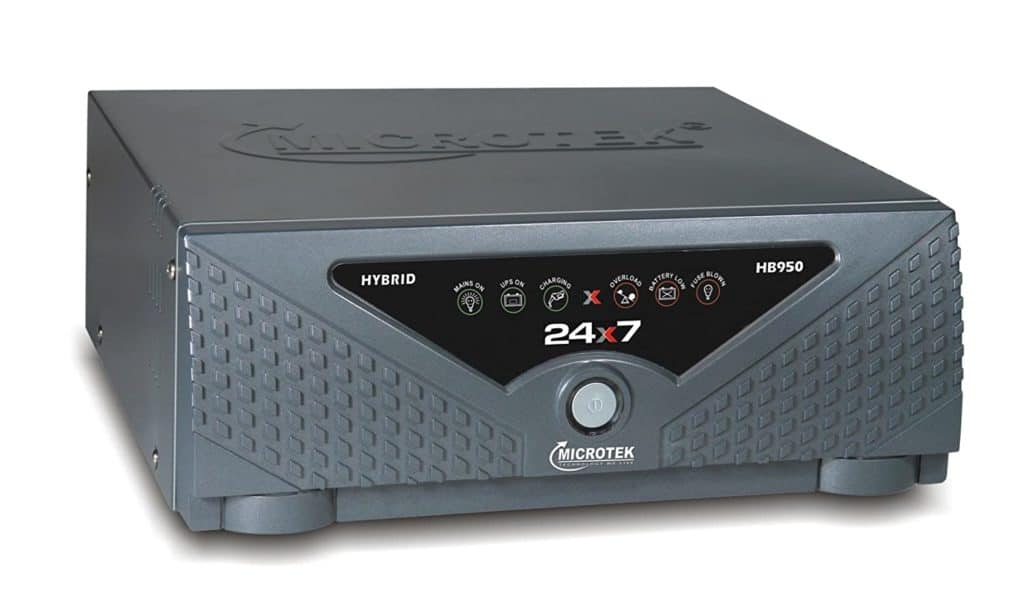
The ups sinewave is a new and improved version of the ups Microtek hybrid. It comes with an inverter and battery management system (BMS) that are designed to work in tandem, providing a high-performance solution.
The ups sinewave can deliver continuous power for up to 24 hours and a backup capacity of 9 hours. If you want to take advantage of the ups sinewave’s energy-saving features, it will automatically turn off your lights and appliances when they aren’t needed, saving up to 50% of your monthly energy bill.
You can also control the ups sinewave remotely with a smartphone app, so you don’t have to worry about being home when power failures occur.
This ups sinewave is built with a high-capacity lithium-ion battery that offers high energy density, which means that it stores more power than other batteries. It comes with an inbuilt bypass switch, which ensures that it only draws power when there is an actual power outage.
The ups sinewave has a charging current of 10 amps and a maximum output power of 760 watts. It also comes with a 5-year limited warranty for parts and labor. It can be used in conjunction with a solar panel, so it won’t lose power if the sun goes down.
Pros
- The ups sinewave has a continuous power output of 24 hours and a backup capacity of 9 hours. So you will always have enough power to keep your home or business operating.
- This inverter has a built-in bypass switch, which makes sure that it only draws power when there is an actual power outage.
- It has an efficiency rating of 93%, which is higher than most other inverters on the market.
Cons
- It is a bit pricey which could count as a disadvantage.
6. Exide Technologies 850Va Pure Sinewave Home Ups Digital Display Inverter
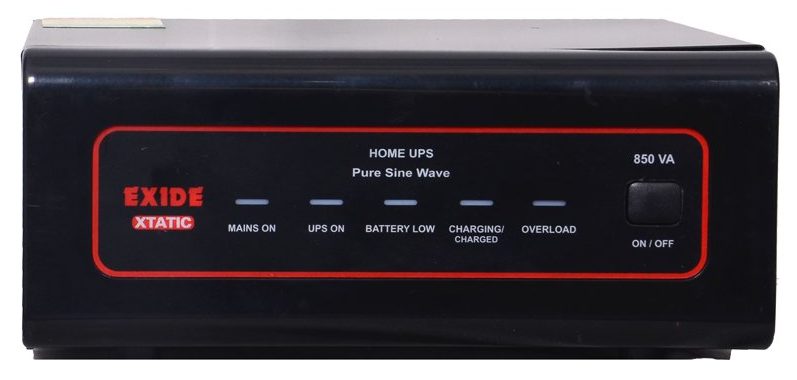
Exide Technologies has been producing quality chargers for over 30 years. They were one of the very first companies to mass-produce solar chargers, and they still are one of the very best.
Their chargers are known for their rugged construction, ease of use, and superior efficiency. They offer a wide range of options, from simple trickle chargers for boats and RV’s, all the way up to a full array of features like LCDs and reverse polarity protection.
This model is a Pure Sinewave Inverter, which means that it only uses the positive portion of the AC. This makes it much more efficient and extends the life of your battery.
It has a built-in high-capacity water-resistant 1000mAh deep-cycle battery that provides up to 10 hours of runtime. It also has an AC input of 100-240V, so it can be used almost anywhere in the world.
It has a convenient USB output that lets you charge almost any mobile device (like your cell phone, MP3 player, digital camera, or PDA) right from the charger.
It has overload protection and short circuit protection. It also comes with a 3-year warranty. It is by far the most efficient, the easiest to use, and the most feature-packed.
Pros
- It only uses the positive half of the current, meaning it uses less power than other models that use the full current.
- It is known for its rugged construction – it is designed to withstand the elements.
- It comes with a built-in battery – provides 10 hours of runtime on a single charge.
Cons
- It has no display so you’ll need to buy an external display if you want one.
Buying Guide For The Best Inverter For Home
Have you been looking for the best inverter for home use? If so, we have you covered. We’ve researched and compiled the best inverters for a home in this guide, based on their reliability, efficiency, durability, and ease of use.
When you’re looking for the best inverter for home use, you’ll want to know all of the important things. Read this guide to get a clear understanding of the Best inverters for the home.
Considerations
What Type Of Inverter Do You Need?
There are three basic types of inverters and each has different advantages and disadvantages. Here’s a quick overview of what you need to know when you’re making your decision.
- Fixed Frequency Inverter (FFI) – The most common type of inverter used in the US. An FFI will run at a specific frequency (usually 60 or 50 Hz) and can only produce one frequency.
This means an FFI will produce power at the same frequency as the power line coming into your home. FFIs are simple, inexpensive, and easy to install. They also have a very small environmental impact.
However, FFIs have some drawbacks. For one, they cannot produce power when your home is not using it. Also, an FFI produces a lot of harmonic distortion which can cause radio interference and malfunctioning of sensitive electronics.
- Variable Frequency Inverter (VFD) – A VFD will run at a specific frequency (usually 60 or 50 Hz) and can produce both low and high frequencies. This allows you to cut down on energy consumption by using less powerful appliances when you aren’t using all the appliances in your home.
Using a VFD also increases the life of your appliances because they don’t have to work as hard when they are producing less power. VFDs also have a very small environmental impact. However, VFDs have some drawbacks.
For one, they are more complex and expensive than FFIs. Also, they cannot produce power when your home is not using it. Also, they cannot produce power when your home is operating on a power source with high harmonics (a power line has lots of these).
- Combined Inverter/Converter – A combined inverter/converter will run at a specific frequency (usually 60 or 50 Hz) and can produce both low and high frequencies.
This allows you to cut down on energy consumption by using less powerful appliances when you aren’t using all the appliances in your home. Using a combined inverter/converter also increases the life of your appliances because they don’t have to work as hard when they are producing less power.
Combined inverter/converters also have a very small environmental impact. However, combined inverter/converters are more complex and expensive than either an FFI or VFD.
Also, they cannot produce power when your home is not using it. Also, they cannot produce power when your home is operating on a power source with high harmonics (a power line has lots of these).
Voltage And Capacity Requirements Of Your Appliances
The first consideration is what appliances you plan to power with your inverter. You’ll need to have at least one appliance (your inverter) on a circuit of its own.
You should also pay close attention to the voltage requirements of all the appliances you plan to use with your new inverter. Most inverters are designed to handle 120 volts AC, 60 Hz (the standard in the U.S.), but many older models may only be able to handle 110 volts.
Newer inverters are usually 110/120-volt units and will work just fine with older equipment. However, if you have newer appliances that require 120 volts, you’ll need to get an inverter that has a voltage rating of at least 2.
If you’re unsure about the voltage requirement of any of your appliances, simply contact the manufacturer or retailer of the equipment and they’ll be happy to provide you with the information you need.
Consider The Size Of Your Home And Lot Size
Another important consideration is the size of your home and the size of the lot on which your home is located. You’ll need to take this into account when you are calculating how much power you’ll use with your new inverter.
You should also keep in mind that larger homes will require more electrical service than smaller homes. In addition, homes located on larger lots will generally use more electrical service than those located on smaller lots.
This is because the larger the home, the greater the distance between the home and the electrical service pole (or the substation). Therefore, the length of cable you’ll need to run from your electrical service panel to your home will be proportionately longer, thus using more electricity. ,0
Consider Your Budget
If you don’t want to spend the extra money on an inverter, you can still get the same benefits by using a regular wall outlet timer, which will automatically turn off appliances at night and when you leave the house.
In addition to saving money, an inverter will help you save energy. The average American home uses about 15 kilowatts (kW) per hour of electricity. That’s about 4,000 kWh each year.
While that may not seem like much, it adds up quickly, so it’s important to have a plan to cut back on your energy consumption and save money on your utility bills.
Conclusion – Best Inverter For Home
Inverters are very useful, especially for homes with older appliances. Your home is one of the biggest consumers of electricity in your entire life. It is truly an “energy hog” and using less electricity will almost certainly pay huge dividends in the long run.
Therefore, installing a whole-house inverter is a good idea, even if you don’t have any old appliances lying around that need powering up. Also, if you do have older equipment that needs recharging, using an inverter is a must.
Inverters can be used with brand new equipment, as well. Thus, here we enlisted all the benefits of using an inverter and also some of the best inverters for the home. I hope you liked this article. If you have any questions, please don’t hesitate to leave a comment below. Thanks for reading!
